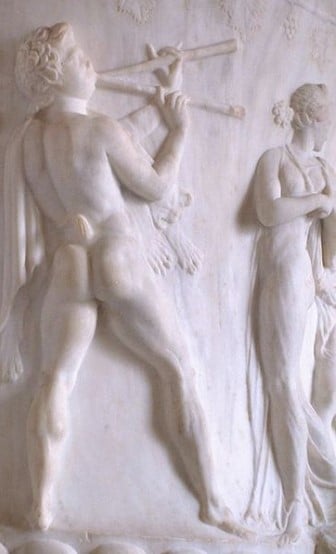- Fulvio Corsini bronze sculpture, Siena, late 19th early 20th century
Bronze sculpture depicting a young diaulos player, dressed in old-fashioned sandals, a crown and a skirt of leaves; face turned upwards, following the arched line of his body. Resting on a base decorated with rams’ heads, laurel festoons and ribbons. Signature engraved on the base “Fulvio Corsini”.
Dimensions: 100 x 36 x 57cm. Base 28 x 28cm.
CODE: OGANBR0196019
Fulvio Corsini (Siena, 1874 – 1938) was an artist and sculptor who lived at the turn of the 19th and 20th centuries, also remembered as a restorer. Initially trained in his father’s workshop, he continued and perfected his studies of materials and techniques linked to the artisan tradition at the Academies of Fine Arts in Rome and Florence, arriving at an exemplary mastery of the sculptural art of wood, terracotta, of bronze and marble.
He carried out important commissions including, in 1905, the new statues of Saints Bartholomew and Mark, as part of the ministerial project to integrate the missing statuary on the façade of the Siena Cathedral. Among the various works by him, two bronze statues depicting “L’Armonia” and “La Melodia” are kept in Palazzo Chigi Saracini, in the Concert Hall. He held the role of teacher at the Academy of Fine Arts and the Art Institute of Siena, appearing as deputy director of the latter from 1927; he was also among the exhibitors at the “Sanremo Prizes” for sculpture in 1938. his medals, exhibited both in national and international exhibitions, are part of the collection of the Italian Mint.


Finally, it is important to remember that Fulvio Corsini was a teacher and friend of the Italian archaeologist, art historian and politician Ranuccio Bianchi Bandinelli, who in all probability contributed to instilling a certain “archaeological taste” in the sculptor, clearly visible inside the a work analyzed here, recalling in a very clear way an iconographic model (the young man or the satyr playing diaulos) present in ancient classical Greek and Roman art.
Comparison bibliography.
Panzetta A., New Dictionary of Italian Sculptors of the Nineteenth and Early Twentieth Centuries, (SculturAdArte), AdArte, Turin, 2003, p. 229.

FineArt is the new ambitious Di Mano in Mano project that offers an exclusive choice of antiques and design works, presenting them for their singularity and uniqueness.

FineArt by Di Mano in Mano is a team of experts at your service to enhance furniture, paintings, finest antiques, art and design masterpieces at best.
Di Mano in Mano
Via Castellazzo 8, Cambiago (MI)
20040